Instruments Short Answers
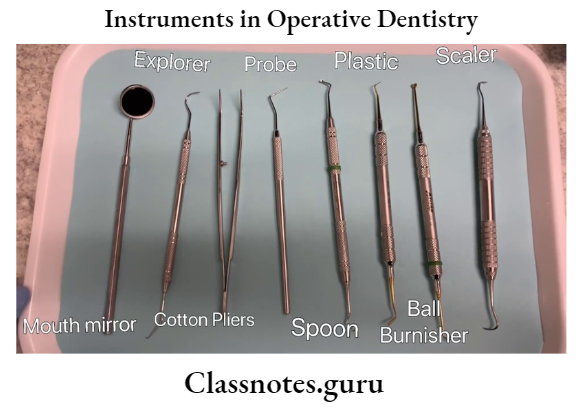
Question 1. Slow Speed.
Answer:
Slow Speed Range:
- 5002500 rpm
Slow Speed Bur Used:
- Steel bur
Slow Speed Uses:
- Polishing
- Finishing
- Drilling holes
- Implants
- Excavation of caries
Slow Speed Advantages:
- Good tactile sense
Slow Speed Disadvantages:
- Inefficient
- Operator fatigue
- Patient discomfort
Question 2. 245 bur.
Answer:
- It is nonstandard carbide bur
- Designed to combine rounded corners with flat ends
- ADA size number 330L
- ISO size number 008
- Head diameter 0.80 mm
- Head length 3 mm
- Shape pear, elongated
Question 3. Enamel Hatchet.
Answer:
- Paired instrument
- Blade angle 4590°
- Bevel Unibevel/Bibeveled
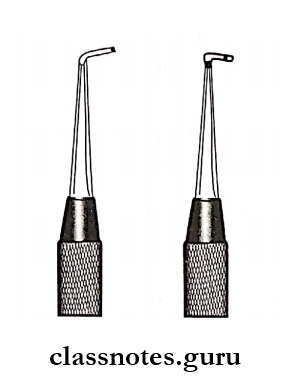
Enamel Hatchet Use:
- Unibevelled instrument
- Cleaving of enamel
- Planning of dentinal walls
1. Bibevelled:
- Use in a chopping motion
- Refine line and point angle
Question 4. AngleFormer.
Answer:
- Type of excavator, mono-angled instrument
- Cutting edge angle 8085°
- Paired instrument
- Blade Beveled on sides as well as at the end
- Manner of using Push or pull motion
- Use Establish retention form in DFG restoration
- Planning the gingival cavosurface margin
Question 5. High Speed.
Answer:
- Speed 20,000 1,20,000 RPM
- Burs used diamond burs with lubricant
High Speed Uses:
- Tooth preparation
- Refining tooth preparation
- Refining occlusion
High Speed Advantages:
- Fine tactile sense
- Minimum over cutting
High-Speed Disadvantages:
- Heat production
- Not fit for larger preparation
- Operator fatigue
Question 6. Dental Bur.
Answer:
Dental Bur Definition:
Dental Bur is defined as a rotary cutting instrument with cutting heads of various shapes and two or more sharp-edged blades, used as a rotary grinder
Dental Bur Classification:
1. According To Their Mode Of Attachment To The Handpiece
- Latch type
- Friction grip type
2. According To Their Composition
- Stainless steel
- Tungsten carbide
- Combination
3. According To Their Motion
- Right bur Revolves clockwise
- Left bur Revolves anticlockwise
4. According To The Length Of Their Head
- Long
- Short
- Regular
5. According To Their Use
- Cutting burs
- For finishing and polishing
6. According To Their Shapes
- Round
- Pear shaped
- Inverted cone
- Wheel shaped
- Tapering fissure
- Straight fissure
Question 7. Grasps are used with Hand Instruments.
Answer:
1. Modified Pen Grasp:
- Middle finger pad placed over shank
- Index finger Bend over middle phalanges and placed over the middle finger
- Thumb Placed on the opposite side of the instrument
Modified Pen Grasp Advantages:
- Creates tripod effect
- Enhances instrument control stabilizers instru¬ment
Modified Pen Grasp Uses:
- Commonly used in mandibular teeth
2. Inverted Pen Grasp:
- Similar to a modified pen grasp
- Palm faces toward the operator
Inverted Pen Grasp Uses:
- Lingual surface of maxillary anterior
- Occlusal surface of maxillary posteriors
3. Palm And Thumb Grasp:
- The shaft placed on the palm of the hand and grasped by four fingers
- The thumb is free to control movements
Palm And Thumb Grasp Use:
- Holding handpiece
- Cutting incisal retention for Class 3
4. Modified Palm And Thumb Grasp:
- Provides more control to avoid slipping of instrument
- Used for maxillary anterior
Question 8. Speed in operative Density
Answer:

Question 9. Rake angle.
Answer:
- It is the angle between the rake face and the radial line
- Positive Rake Angle Radial line is ahead of rake face
- Negative Rake Angle Rake face is ahead of radial line
- Zero Rake Angle Rake face and radial line coincide
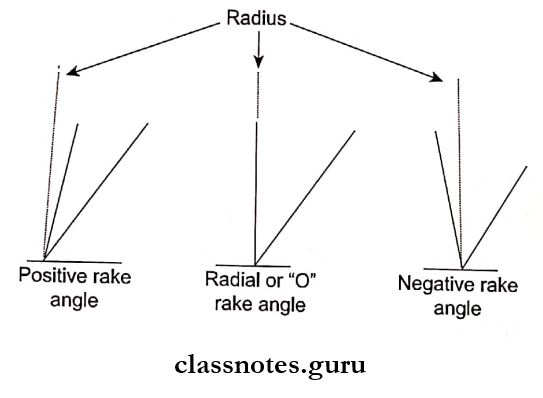
Question 10. Wedel Staedt Chisel.
Answer:
- Have slightly curved shanks
- Used on anterior teeth
- It is a single plane, unibevel instrument
- Used for cleaving undermined enamel
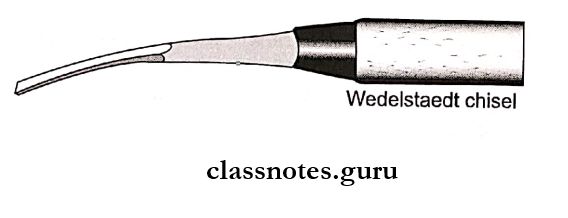
Question 11. Balancing of Hand Instrument.
Answer:
- Balancing is achieved by providing angles in the shank of the instrument so that the cutting edge is within 23 mm of the long axis of the instrument
- It provides better access
- It is also called contra angling
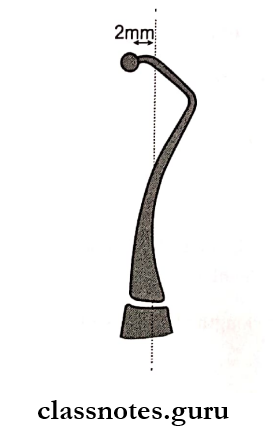
Question 12. Spoon Excavator.
Answer:
- It is a modified hatchet
- Double ended instrument
- BladeSpoon, claw or disk-shaped
- Use Removal of caries and debris
- Manner of use Scooping motion
Question 13. Advantages and Disadvantages of Burs.
Answer:
Burs Advantages:
- Precise
- Easy to control
- Tactile perception
- Removal of debris
Burs Disadvantages:
- Pain
- Vibration
- Noise production
- Pulpal damage
- Over cutting
